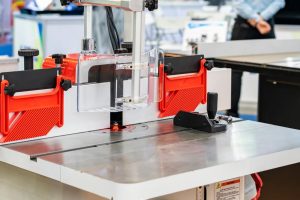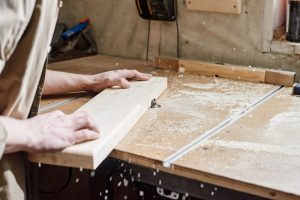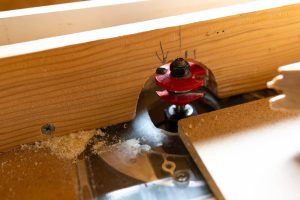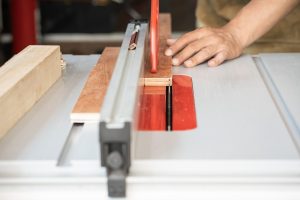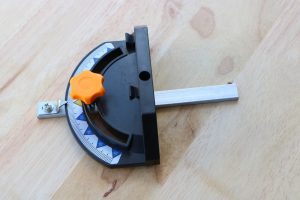A table saw is a versatile and powerful woodworking tool essential for both professionals and hobbyists. At its core, a table saw consists of a flat, stable surface with a rotating circular blade protruding through it, allowing users to make precise and efficient cuts.
The tool’s main function is to cut wood accurately, but it can also handle other materials such as plastic and metal with the right blade. Due to its precision and ease of use, a table saw is highly valued in various applications, from intricate cabinetry and furniture-making to general carpentry and DIY home projects.
Table saws are prized for their ability to make quick, repeatable cuts, such as rip cuts (lengthwise cuts) and crosscuts (across the grain). They’re essential for projects that demand consistent, accurate dimensions. How does a table saw work? Learning is important for new users.
This comprehensive guide helps you to know the different types available and crucial safety practices. By understanding these fundamentals, users can maximize both the tool’s performance and their safety while working on woodworking projects.
What is a Table Saw?
A table saw is a piece of woodworking machinery designed to make accurate, straight cuts in various materials, most commonly wood. Defined by its stationary, flat table surface and a circular saw blade that protrudes through the middle, a table saw is one of the most essential tools in any woodworking setup.
Table saws are widely used across different industries, including furniture-making, cabinetry, construction, and DIY home improvement projects. They are invaluable in any setting that requires quick, consistent, and repeatable cuts, which are critical in projects where uniformity and accuracy are essential.
With different types of table saws, such as benchtop, contractor, and cabinet models, users can choose the saw that best fits their workspace, power needs, and project demands, making it a versatile addition to any woodworker’s toolkit.
Types of Table Saws
There are several types of table saws, each tailored to different woodworking needs. Here’s a look at the most common types:
Benchtop Table Saws
These are lightweight and compact, ideal for small projects and limited workspace. Due to their size and portability, they are commonly used by DIY enthusiasts and are easily transported. However, their smaller motors and lighter frames make them less suitable for heavy-duty projects.
Contractor Table Saws
Originally designed for on-site work, contractor saws are portable but offer more power and stability than benchtop models. They have a larger table surface, making them suitable for medium-sized projects. While more versatile, they are also heavier and typically require a stand or table to operate comfortably.
Cabinet Table Saws
Built for high precision and heavy-duty use, cabinet saws are popular in professional woodworking shops. They feature a powerful motor enclosed in a cabinet base, which reduces noise and vibration. These saws are designed for accuracy and stability, ideal for cutting large wood pieces. However, their size and weight make them difficult to move and require a dedicated workspace.
Hybrid Table Saws
A mix of contractor and cabinet saw features, hybrid table saws are suitable for serious hobbyists and advanced woodworkers. They offer good power and precision while remaining more affordable and slightly more portable than cabinet saws. However, they may still require substantial space and are heavier than contractor saws.
Each type has unique pros and cons, from the portability of benchtop saws to the power and precision of cabinet saws, allowing users to choose the best fit for their specific needs and workspace.
Key Components of a Table Saw
Understanding the key components of a table saw helps ensure efficient and safe use:
Blade
The blade is the core cutting component, available in various sizes and types, such as rip blades for straight cuts and crosscut blades for finer cuts. Blade size impacts the cutting depth, and different materials require specific blade types to ensure smooth, clean cuts.
Motor
Table saws can have either direct drive or belt drive motors. Direct drive motors connect directly to the blade, which is typical for smaller saws, providing high RPMs but less torque. Belt drive motors, found in more robust saws, use a belt and pulley system to increase power and reduce vibration, making them ideal for heavy-duty tasks.
Table
The flat work surface where material is placed. A smooth, durable table is essential for stability and precision in cuts. Larger tables accommodate bigger materials, enhancing the versatility of the saw.
Fence System
The fence is a guide that keeps the material aligned for accurate rip cuts. A stable, adjustable fence is crucial for straight, consistent cuts and helps prevent the material from shifting during operation.
Miter Gauge
This adjustable guide helps make angled cuts, allowing users to crosscut wood at various angles. It’s an essential tool for creating miters, bevels, and other angled joints in woodworking projects.
Dust Collection Port
Effective dust management is important for both visibility and health. A dust collection port allows users to connect a vacuum or dust collector to remove sawdust, maintaining a cleaner workspace and reducing airborne particles.
Additional Safety Features
Table saws are equipped with safety features like anti-kickback pawls, which prevent wood from kicking back toward the operator; blade guards, which shield the blade; and riving knives, which prevent the wood from pinching the blade and reduce kickback risk.
These components, when used correctly, ensure not only the saw’s performance but also the user’s safety and precision in every cut.
How Does a Table Saw Work?
A table saw operates on a straightforward yet powerful mechanism that enables precise, efficient cutting. The core mechanics involve a circular blade powered by a motor, which spins at high speeds to cut through various materials. Here’s a step-by-step breakdown of how it works:
Blade Mechanics and Material Feeding
The table saw blade, typically made of carbide or steel, protrudes through an opening in the table surface. The blade spins at high speed, driven by a motor, creating the force needed to cut wood and other materials.
To cut, the user feeds the material toward the blade, holding it steady and using guides like the fence or miter gauge to ensure accuracy. The speed and sharpness of the blade allow it to slice cleanly, whether cutting with or against the grain.
Role of the Motor
The motor is the powerhouse of the table saw, converting electrical energy into mechanical energy to rotate the blade. There are two main types of motor systems in table saws: direct drive and belt drive.
Direct drive motors are typically found in lighter, portable saws, where the motor directly spins the blade. Belt drive motors, more common in heavy-duty saws, use a belt and pulley system to power the blade. Belt drive motors generally provide more torque and stability, making them preferable for precision work.
Fence and Miter Gauge for Accuracy
The fence is a straight guide positioned parallel to the blade and is essential for making straight, accurate cuts. By adjusting the fence, the user can set the desired width of a rip cut, ensuring consistency across multiple pieces.
The miter gauge is used for angled cuts, allowing users to position the wood at various angles for crosscuts and bevels. Both components are crucial in keeping the material stable, guiding it precisely to achieve the intended cut.
Different Cutting Techniques
- Rip Cuts: The most common cut, a rip cut, slices material along its grain or length. The fence is positioned parallel to the blade, guiding the wood straight through the blade to achieve a uniform width.
- Crosscuts: A crosscut is made across the wood grain, typically used to trim pieces to length. With the miter gauge set to a 90-degree angle, the wood is guided perpendicularly to the blade.
- Beveled Cuts: By tilting the blade at an angle, a beveled cut can be made for angled edges, which are often used in joinery for aesthetics or to create angled joints.
By understanding these mechanics, users can effectively operate a table saw to make precise, repeatable cuts in various woodworking projects.
Types of Cuts Made with a Table Saw
Table saws are versatile tools that support several types of cuts essential in woodworking. Here’s a look at the primary cut types:
- Rip Cuts: These cuts are made along the length of the wood, following the grain. Rip cuts require positioning the fence parallel to the blade at the desired distance, which allows the material to be pushed straight through the saw. Rip cuts are commonly used to cut large sheets or boards into narrower sections.
- Crosscuts: Unlike rip cuts, crosscuts are made across the wood grain, typically used to shorten or square off wood pieces. Using the miter gauge, the wood is guided perpendicularly to the blade, making it ideal for cutting wood to specific lengths or creating straight edges.
- Beveled Cuts: Bevel cuts are angled cuts along the edge of the material. To achieve this, the blade is tilted to the desired angle, and the wood is fed along the fence. Beveled cuts are often used for decorative edges or for creating angled joints in furniture making.
- Dado Cuts: Dado cuts are grooves cut across the wood grain, used in joinery to interlock pieces. These cuts require a special dado blade, which can cut wider slots, making it ideal for creating grooves or housing joints in shelves and cabinetry.
Each type of cut serves a specific function, adding to the table saw’s versatility in woodworking and joinery projects.
Safety Tips for Using a Table Saw
Operating a table saw requires strict adherence to safety guidelines to prevent accidents and injuries. Here are key safety tips for table saw use:
Use of Personal Protective Equipment (PPE)
Always wear safety goggles to protect your eyes from flying debris and ear protection to reduce noise exposure. Gloves can also be useful, but avoid wearing loose clothing, which may get caught in the blade.
Safety Features
Utilize built-in safety features such as the blade guard and riving knife. The blade guard covers the blade, shielding the user from accidental contact, while the riving knife prevents wood from pinching the blade, reducing the risk of kickback—a sudden force that can propel the wood back toward the operator.
Handling Techniques to Prevent Kickback
Kickback is one of the most common hazards when using a table saw. To prevent it, maintain firm, consistent pressure on the wood, using the fence or miter gauge as a guide. Always feed the wood slowly and smoothly, avoiding any jerking motions, which can destabilize the material and lead to kickback.
Common Mistakes to Avoid:
- Incorrect Blade Height: Set the blade height so that only the top third of the blade is above the wood. This minimizes exposure and improves control.
- Misaligned Fence: Ensure that the fence is perfectly parallel to the blade. A misaligned fence can cause binding, increasing the chance of kickback.
- Inattentiveness: Focus entirely on the cut, avoiding distractions while the saw is running. Always wait until the blade has come to a full stop before removing any offcuts.
These precautions, combined with a good understanding of how to operate and maintain the saw, greatly enhance safety and confidence during use, making the table saw an invaluable and safer tool for woodworking.
Conclusion
Understanding how does a table saw work is crucial for anyone looking to use this powerful woodworking tool safely and effectively. From its core mechanics to the different types of cuts it can perform, a table saw is essential for achieving precision in woodworking projects. Key components like the blade, motor, fence system, and miter gauge all work together to allow for a range of cuts, including rip cuts, crosscuts, bevels, and dados.
However, due to its power, proper safety practices are essential to prevent accidents. Using safety features, adhering to recommended handling techniques, and avoiding common mistakes are all part of responsible table saw operation.
With practice and a commitment to learning, users can build both skill and confidence, enhancing their ability to use the saw safely and skillfully in a variety of projects. Safe woodworking practices will ensure the best results and a rewarding woodworking experience.
